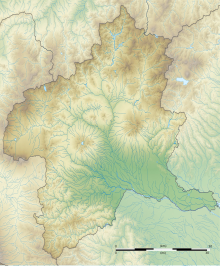
Takeda Shingen was daimyo of Kai Province during the Sengoku period of Japan. Known as "the Tiger of Kai", he was one of the most powerful daimyo of the late Sengoku period, and credited with exceptional military prestige. Shingen was based in a poor area with little arable land and no access to the sea, but he became one of Japan's leading daimyo. His skills are highly esteemed and on par with Mōri Motonari.
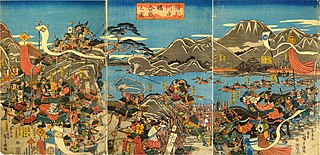
The Battles of Kawanakajima were a series of battles fought in the Sengoku period of Japan between Takeda Shingen of Kai Province and Uesugi Kenshin of Echigo Province from 1553 to 1564. Shingen and Kenshin contested each other for control of the plain of Kawanakajima between the Sai River and Chikuma River in northern Shinano Province, located in the present-day city of Nagano. The battles were triggered after Shingen conquered Shinano, expelling Ogasawara Nagatoki and Murakami Yoshikiyo, who subsequently turned to Kenshin for help.
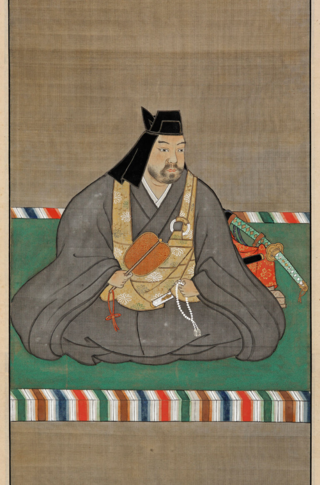
Nagao Kagetora, later known as Uesugi Kenshin, was a Japanese daimyō. He was born in Nagao clan, and after adoption into the Uesugi clan, ruled Echigo Province in the Sengoku period of Japan. He was one of the most powerful daimyō of the Sengoku period. Known as the "Dragon of Echigo", while chiefly remembered for his feats and prowess on the battlefield as a military genius and war hero, Kenshin is also regarded as an extremely skillful administrator who fostered the growth of local industries and trade, and his rule saw a marked rise in the standard of living of Echigo.

The Battle of Mikatagahara took place during the Sengoku period of Japan between Takeda Shingen and Tokugawa Ieyasu in Mikatagahara, Tōtōmi Province on 25 January 1573. Shingen attacked Ieyasu at the plain of Mikatagahara north of Hamamatsu during his campaign against Oda Nobunaga while seeking a route from Kōfu to Kyoto. The Tokugawa-Oda force was almost totally annihilated by the Takeda after being encircled and many of Ieyasu's retainers were killed in the battle. Ieyasu and his surviving men were forced to retreat before launching a minor counterattack to delay Shingen's march towards Kyoto.

Murakami Yoshikiyo was a Japanese samurai from the Murakami clan and retainer of the Uesugi clan during the Sengoku period of the 16th century. Yoshikiyo followed in fighting against both Takeda Nobutora and his son Takeda Shingen. Yoshikiyo was also a very close ally under Uesugi Kenshin and one of Shingen's bitterest opponents for his high kill-counts in their conflicts.

Uesugi Kagekatsu was a Japanese samurai daimyō during the Sengoku and Edo periods. He was the adopted son of Uesugi Kenshin and Uesugi Kagetora’s brother in law.

Kōsa, also known as Hongan-ji Kennyo, was the 11th head of the Hongan-ji in Kyoto, and Chief Abbot of Ishiyama Hongan-ji, cathedral fortress of the Ikkō-ikki, during its siege at the end of the Sengoku period. He engineered many alliances, and organized the defenses of the cathedral to the point that most at the time considered Ishiyama Hongan-ji to be unbreachable.

Kōsaka Masanobu also known as Kasuga Toratsuna was a Japanese samurai warrior of the Sengoku period. He was known as one of the "Twenty-Four Generals of Takeda Shingen". He is often credited as the original author of Kōyō Gunkan, which records the history of the Takeda family and their military tactics.

Uesugi Norimasa was a daimyō of feudal Japan from Yamanouchi branch Uesugi clan and held the post of Kantō Kanrei, the shōgun's deputy in the Kantō region. He was the adoptive father of Uesugi Kenshin, one of the most famous warlords in Japanese history.

Hōjō Ujiyasu was a daimyō (warlord) and third head of the Odawara Hōjō clan. Known as the "Lion of Sagami", he was revered as a fearsome samurai and a cunning man. He is famous for his strategies of breaking the siege from Takeda Shingen and Uesugi Kenshin. A son of Hōjō Ujitsuna, his only known wife was Imagawa Yoshimoto's sister, Zuikei-in. Among his sons are Hōjō Ujimasa and Uesugi Kagetora.
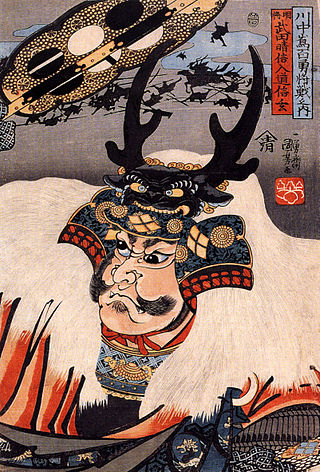
The Kōyō Gunkan (甲陽軍鑑) is a record of the military exploits of the Takeda family, compiled largely by the Takeda vassal Kōsaka Danjō Masanobu, and completed in 1616 by Obata Kagenori. It provides some of the most detailed descriptions and statistics of warfare in the Sengoku period available today. The term Bushidō was first used in Kōyō Gunkan.
Uesugi Kagetora was the seventh son of Hōjō Ujiyasu; known as Hōjō Saburō, he was adopted by Uesugi Kenshin, and was meant to be Kenshin's heir. However, in 1578, he was attacked in his castle at Otate by Uesugi Kagekatsu—Kagetora's respective brother-in-law—and was subsequently defeated. Kagetora committed suicide the following year in Samegao Castle.
The siege of Shika castle, which took place in September 1547, was one of many battles fought in Takeda Shingen's bid to seize control of Shinano Province.

The 1547 Battle of Odaihara was one of a series of battles waged by Takeda Shingen in his long campaign to conquer Shinano province. In this particular encounter he was fighting the forces of Uesugi Norimasa, who was based in Echigo province but had decided to intervene in Shinano to prevent Shingen from overrunning the whole province. The Uesugi army attempted to relieve the castle of Shika, which Shingen had besieged, but were attacked and defeated at Odaihara on 19 September 1547.
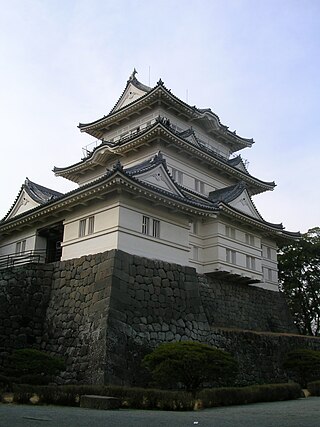
In the 1561 siege of Odawara, a battle of Japan's Sengoku period, Uesugi Kenshin attacked Odawara castle. This was the first of several sieges which would befall Odawara castle, the home castle of the Hōjō clan.
The 1566 siege of Minowa was one of several battles fought by the Takeda clan in their campaigns to seize the lands of the Uesugi clan, during Japan's Sengoku period. It is part of a larger power struggle between Takeda Shingen and Uesugi Kenshin.

Honjō Shigenaga was a Japanese Samurai who lived from the Azuchi–Momoyama period through to the Edo period. Shigenaga served the Uesugi clan and was known for his betrayal against them. He held the court title Echizen no kami.
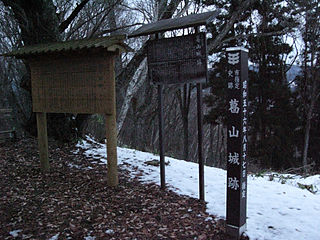
The siege of Katsurayama in March 1557 was fought between the forces of the Japanese daimyō Takeda Shingen and Uesugi Kenshin as part of the Kawanakajima campaigns. Katsurayama Castle was a strategically vital Uesugi stronghold in the contested Shinano Province and, when it was isolated from reinforcements due to late snow in early 1557, the Takeda clan used this opportunity to attack it. Although the castle garrison, consisting of the Ochiai clan and elements of the Murakami clan, defended Katsurayama furiously, the Takeda forces under Baba Nobuharu eventually stormed into the castle. Most of the garrison was killed in combat, while the families of the defenders committed mass suicide and the castle was burned to the ground.

Samegao Castle was a Sengoku period yamashiro-style Japanese castle located in what is now the Yukimori and Miyauchi neighborhoods of the city of Myōkō, Niigata Prefecture in the Hokuriku region of Honshu, Japan. The ruins have been protected as a National Historic Site since 2008.

Iiyama Castle was a hirayama-style Japanese castle located in what is now part of the city of Iiyama, Nagano prefecture. It was the headquarters for Iiyama Domain under the Edo period Tokugawa Shogunate and its ruins are now a public park.
